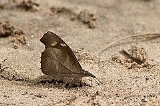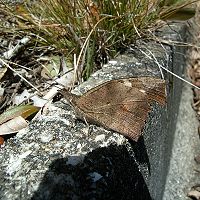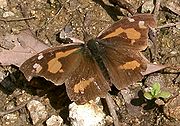
Libythea lepita
Encyclopedia
The Common Beak is a butterfly found in India that belongs to the Libytheinae
group of the Brush-footed butterflies
family.

The species was earlier considered a race of Libythea celtis
(European Beak). The following description is based on the older treatment and the race lepita and lepitoides described below refer to this species.
 The larval food plants of the species include members of the Cannabaceae
The larval food plants of the species include members of the Cannabaceae
particularly in the genus Celtis and Trema
.
as follows : Upperside ground-colour a slightly darker brown. Fore wing : orange-yellow streak in cell much narrower for two-thirds of its length from base, then abruptly expanded anteriorly so as to fill the apex of the cell, the inner margin of the apical portion and the anterior margin of the basal portion forming a clearly defined right angle ; lower discal spot absent, upper larger discal spot somewhat diamond-shaped; subcostal spot and preapical spot placed obliquely outwards from it more distinctly double, the lower portion of the subapical spot orange-yellow, the upper portion and the subcostal spot white. Hind wing: the upper postdiscal orange patch narrower, forming a short band which is no1 curved but placed obliquely transverse, reaching from vein 2 to vein 6, sometimes but rarely with a detached orange spot above it in interspace 6. Underside : ground-colour variable, generally vinous-brown, paler along the costal and dorsal margins of the fore wing; sometimes dark brown on the fore wing, dark greyish on the hind wing, with the costal margin broadly of the fore and the whole of the hind wing irrorated with minute dark striae and spots. Orange and white markings on the fore wing as on the up per side, but the preapical double spot entirely white. The hind wing is more variable; in some specimens it is uniform without any markings, in others it is shaded transversely light and dark, and in a few specimens the wing is longitudinally divided by a dark-brown diffuse band from base along the median vein to apex of vein 5. Antennae, head, thorax and abdomen as in L. celtis.
The Himalayas, Simla to Sikkim, Assam, Upper Myanmar extending to China and Japan.
Hind wing: tornus narrowly produced, dentate or even, subcaudate. Upperside: ground-colour darker brown. Fore wing: the orange-yellow streak in cell divided from the spot in the apex of the cell, the large discal spot smaller, the subcostal and subapical spots more distinctly double, the latter pure white. Hind wing: the transverse short band narrower and more horizontal; a diffuse quadrate pale spot in the middle of interspace 7, larger in the female than in the male. Underside fore wing: ground-colour dark brown, the apex, the termen narrowly and slightly, and the dorsal margin somewhat broadly touched with grey, irrorated with minute dark dots and transverse striae; the orange-yellow and white markings as on the upperside, the former broader and fuller, the cellular streak not interrupted. Hind wing pale grey, shaded broadly at base, on the disc and posteriorly, with brown, the pale grey ground-colour prominently replacing the transverse orange streak and pale subcostal spot of the upperside. In some specimens there is a very dark brown shading from base of the wing along the median vein. The entire surface of the wing is irrorated with minute dots and transverse short striae. Antennae, head, thorax and abdomen as in celtis.
Southern India ; Ceylon.
Libytheinae
Libytheinae is the nymphalid subfamily of the snout butterflies, containing two valid genera and about 10 species, 6 in Libythea and 4 in Libytheana. The common name refers to the thick labial palps that look like a "snout" in this subfamily. In older literature, this group was recognized as the...
group of the Brush-footed butterflies
Nymphalidae
The Nymphalidae is a family of about 5,000 species of butterflies which are distributed throughout most of the world. These are usually medium sized to large butterflies. Most species have a reduced pair of forelegs and many hold their colourful wings flat when resting. They are also called...
family.

Description
- See glossaryGlossary of Lepidopteran termsThis glossary describes the terms used in the formal descriptions of insect species, jargon used mostly by professionals or entomologist....
for terms used
The species was earlier considered a race of Libythea celtis
Libythea celtis
The European Beak or Nettle-tree Butterfly is a butterfly of the Libytheinae group of the Brush-footed butterflies family.-Description:The upperside ground colour is rich silky brown...
(European Beak). The following description is based on the older treatment and the race lepita and lepitoides described below refer to this species.

Cannabaceae
Cannabaceae are a small family of flowering plants. As now circumscribed, the family includes about 170 species grouped in about 11 genera, including Cannabis , Humulus and Celtis...
particularly in the genus Celtis and Trema
Trema
Trema is a genus of about 15 species of evergreen trees closely related to the hackberries , occurring in subtropical and tropical regions of southern Asia, northern Australasia, Africa, South and Central America, and parts of North America...
.
Race lepita, Moore
Differs from the European beak Libythea celtisLibythea celtis
The European Beak or Nettle-tree Butterfly is a butterfly of the Libytheinae group of the Brush-footed butterflies family.-Description:The upperside ground colour is rich silky brown...
as follows : Upperside ground-colour a slightly darker brown. Fore wing : orange-yellow streak in cell much narrower for two-thirds of its length from base, then abruptly expanded anteriorly so as to fill the apex of the cell, the inner margin of the apical portion and the anterior margin of the basal portion forming a clearly defined right angle ; lower discal spot absent, upper larger discal spot somewhat diamond-shaped; subcostal spot and preapical spot placed obliquely outwards from it more distinctly double, the lower portion of the subapical spot orange-yellow, the upper portion and the subcostal spot white. Hind wing: the upper postdiscal orange patch narrower, forming a short band which is no1 curved but placed obliquely transverse, reaching from vein 2 to vein 6, sometimes but rarely with a detached orange spot above it in interspace 6. Underside : ground-colour variable, generally vinous-brown, paler along the costal and dorsal margins of the fore wing; sometimes dark brown on the fore wing, dark greyish on the hind wing, with the costal margin broadly of the fore and the whole of the hind wing irrorated with minute dark striae and spots. Orange and white markings on the fore wing as on the up per side, but the preapical double spot entirely white. The hind wing is more variable; in some specimens it is uniform without any markings, in others it is shaded transversely light and dark, and in a few specimens the wing is longitudinally divided by a dark-brown diffuse band from base along the median vein to apex of vein 5. Antennae, head, thorax and abdomen as in L. celtis.
The Himalayas, Simla to Sikkim, Assam, Upper Myanmar extending to China and Japan.
Race lepitoides, Moore
Differs from lepita as follows:Hind wing: tornus narrowly produced, dentate or even, subcaudate. Upperside: ground-colour darker brown. Fore wing: the orange-yellow streak in cell divided from the spot in the apex of the cell, the large discal spot smaller, the subcostal and subapical spots more distinctly double, the latter pure white. Hind wing: the transverse short band narrower and more horizontal; a diffuse quadrate pale spot in the middle of interspace 7, larger in the female than in the male. Underside fore wing: ground-colour dark brown, the apex, the termen narrowly and slightly, and the dorsal margin somewhat broadly touched with grey, irrorated with minute dark dots and transverse striae; the orange-yellow and white markings as on the upperside, the former broader and fuller, the cellular streak not interrupted. Hind wing pale grey, shaded broadly at base, on the disc and posteriorly, with brown, the pale grey ground-colour prominently replacing the transverse orange streak and pale subcostal spot of the upperside. In some specimens there is a very dark brown shading from base of the wing along the median vein. The entire surface of the wing is irrorated with minute dots and transverse short striae. Antennae, head, thorax and abdomen as in celtis.
Southern India ; Ceylon.
See also
- LibytheinaeLibytheinaeLibytheinae is the nymphalid subfamily of the snout butterflies, containing two valid genera and about 10 species, 6 in Libythea and 4 in Libytheana. The common name refers to the thick labial palps that look like a "snout" in this subfamily. In older literature, this group was recognized as the...
- NymphalidaeNymphalidaeThe Nymphalidae is a family of about 5,000 species of butterflies which are distributed throughout most of the world. These are usually medium sized to large butterflies. Most species have a reduced pair of forelegs and many hold their colourful wings flat when resting. They are also called...
- List of butterflies of India
- List of butterflies of India (Nymphalidae)

